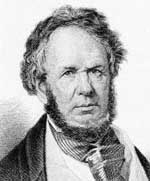Henry Rowe Schoolcraft
Henry Rowe Schoolcraft (born March 28, 1793 in Guilderland , then part of Watervliet , Albany County , New York ; † December 10, 1864 in Washington, DC ) was an American explorer and ethnologist who was best known for the source of the Mississippi River found in 1832.
Schoolcraft's first interests were stones and minerals , which brought him on a geological expedition to Lake Superior in 1820 . He then worked as a map maker and government employee on the Northwest Frontier, near Lake Superior . In 1822 he went to Michigan as an Indian agent and in 1839 was appointed chief agent of the Northern Department Indians. In 1832 he discovered the source of the Mississippi in a lake in northern Minnesota that he named Lake Itasca , after the Latin words caput (head) and veritas (truth).
Schoolcraft was married to Jane Johnston , who was of American Indian-Irish descent. He was interested in the American indigenous population and, with the support of his wife, wrote about their history , language , mythology , hieroglyphics, images, religions , etc. His main work is formed by the Historical and statistical information respecting the, which was undertaken after a congress act and published at the expense of the government history, condition, and prospects of the Indian tribes of the United States (6 vols., 336 copper plates) Philadelphia (1851-1857). His second marriage was to Mary Howard, who came from a plantation family in South Carolina . She wrote the book The Black Gauntlet. A Tale of Plantation Life in South Carolina , where she defended slavery .
In 1847 , Henry Rowe Schoolcraft moved to Washington, where he died on December 10, 1864.
Works
- Travels in the central portions of the Mississippi valley . ( 1825 )
- Narrative of an expedition through the Upper Mississippi to Itasca Lake . ( 1834 )
- Algic researches . 2 vols. New York ( 1839 )
- The myth of Hiawatha and other oral legends . Philadelphia ( 1856 )
- Oneota , or characteristics of the red race of America . New York ( 1844 )
- The Indian in his wigwam . ( 1848 )
- Notes on the Iroquois . Albany ( 1946 )
- The red race of America . ( 1847 )
- Personal memoirs of a residence of thirty years with the Indian tribes . Philadelphia ( 1851 )
- Scenes and adventures in the semi-alpine regions of the Ozark Mountains . Philadelphia ( 1853 )
Others
- Fredrika Bremer describes Schoolcraft in the second volume of her work "The Home in the New World" as "an interesting, benevolent scholar who describes great".
Web links
Individual evidence
- ^ Robert Dale Parker: Jane Johnston Schoolcraft. In: oxfordbibliographies.com. May 19, 2017, accessed February 10, 2020 .
- ↑ Jane Johnston Schoolcraft - History of American Women. In: womenhistoryblog.com. July 17, 2012, accessed February 10, 2020 .
| personal data | |
|---|---|
| SURNAME | Schoolcraft, Henry Rowe |
| BRIEF DESCRIPTION | American ethnologist and discoverer of the Mississippi Spring (1832) |
| DATE OF BIRTH | March 28, 1793 |
| PLACE OF BIRTH | Guilderland , then at Watervliet , Albany County , New York |
| DATE OF DEATH | December 10, 1864 |
| Place of death | Washington, DC |
